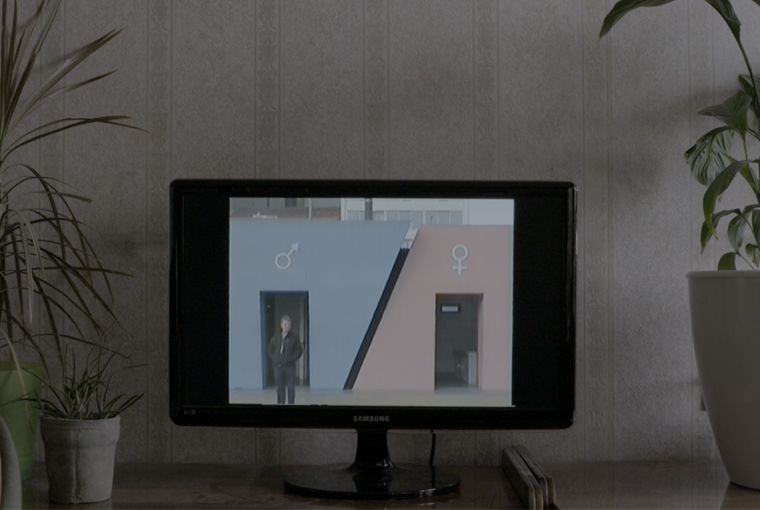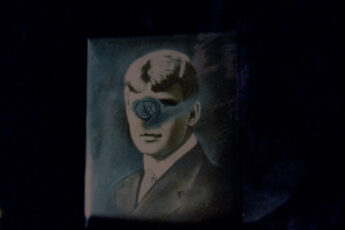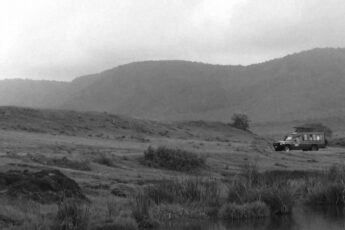Dancing in the Moonlight
Maxim Pechersky’s The Year of the White Moon (God beloy luni, 2020)
Vol. 107 (September 2020) by Yann Kaci
The first shot of The Year of the White Moon embodies the entire tension about to unravel. It presents the spectator with the replica of a church’s skeleton, a very imagistic metaphor for a country with a strong tradition uncontrollably sucked into the vacuum of modernity and progress. The ruin, a theme very much explored by Russian directors – one cannot help but think about Tarkovsky’s hauntologies – stands as a double metaphor both for Russia as a country, and for the relationship between the film’s main characters. The short film centers around a mother and her son with clashing mentalities, the former representing a time where marriage, settling and spirituality were central to Russian existence, while the latter embodies young liberals who live away from their home and families, share progressive views on sexuality, gender and family, and are less and less interested in spirituality, whether it is in the form of organized religions or superstitions.
The music, which both threatens and comforts the viewer with its watery, electronic noises, sets the tone for an introspective and odd short concerned with difficult human bonds, which are epitomized by the near-absence of actors for much of the running time. Instead of bodies, the film is haunted by the ghostly presence of the character’s mediated voices. The first shot also introduces the theme of pagan beliefs and superstitions through a still shot of the statue of a woman whose hat might very well hint at her being the goddess of the moon, Selene, whose influence infuses the entire piece down to its very title. In less than 30 seconds, before the title of the film even appears, Pechersky succeeds in synthesizing the essence and main concerns of his tragicomedy.
The film is almost entirely shot in a deserted home – except for a sequence featuring a wandering, bored husky dog –, focusing in close-up shots on a chandelier, a sofa, cracks on the ceiling and a TV set, which happens to be the main focus as well as the locus of the film’s narrative. The spectator is invited into the intimacy of a living room which features no human traces except for disembodied voices. The action of the film is delivered through a phone conversation that seems to emanate from a TV screen. The conversation between a son living in Moscow and a mother living Ekaterinburg barely surpasses a phatic use of language, as though communication itself was constantly being put in jeopardy. The characters’ geographical distance echoes and mirrors their personal differences. Both characters consistently try to evade the conversation, the mother speaking about trivial things and at one point effectively leaving the conversation to shout at a passer-by for more than half a minute, while the son remains almost silent, eventually ending the conversation by stating that he is not in the mood “for anything”. However, bits of meaningful conversations often emerge and collide in the film, whether it is the son’s homosexuality – that his mother, who is very much aware of it, seems to simply ignore and instantly forget about -, his recent breakup, or his very talkative mother’s uneventful sex life and her greatly detailed myomectomy.
The son, who shares the filmmaker’s name and hometown, turns 21 at the time when the story takes place. According to the mother, her son needs to perform an astrological ritual to the white moon for his 21st birthday, which will bring him good luck and happiness if done well. It is her way of dealing with her incapability to understand her son’s life, as she craves for him to have a wife and children while he wants to be married to a man. Tradition and modernity certainly clash in Pechersky’s film. However, the way the clash is dealt with is subtle. Pechersky draws on silence and tenderness rather than violence, as one might expect from the subject matter, especially when set in homophobic Russia. The film reconciles these two dimensions in a scene where a young man dressed in a white lace wedding dress and a veil, dances to the mother’s voice singing a happy birthday song and wishing him love in what seems to be a karaoke setup. Instead of opting for a confrontational, agonistic approach to this conflict of values, the film unearths with great subtlety the meaning that is contained in silence and small talk, shedding light on the human bond that these two people share beyond their differences.
However deep the communication problems that the two characters face may be, their conversation, which lasts for most of the short, also appears as a sanctuary sheltering them from a cruel outside world epitomized by the mother’s binge-watching of nature documentaries on Nat Geo Wild HD, where “lions [are] fighting hyenas for territory”. It is, in the end, a moving portrait of filial love, care and loneliness that Pechersky presents to his spectators. Pechersky’s maturity and eloquent cinematographic language, which allow him to treat his subject matter with both melancholy and humor, make him a young director to look out for.




Leave a Comment